2017-2018学年人教版初一英语Unit 3 Is this your pencil七年级上册单元测试卷
- 格式:doc
- 大小:158.80 KB
- 文档页数:7
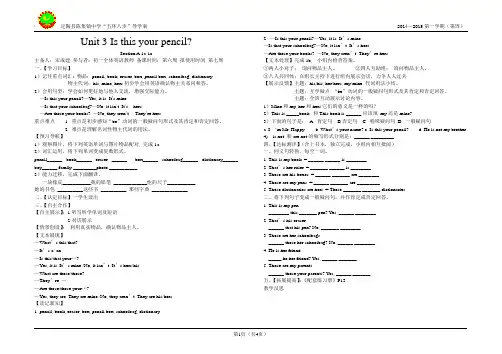
Unit 3 Is this your pencil?Section A 1a-1c主备人:宋成建参与者:初一全体英语教师备课时间:第六周拟使用时间第七周一、【学习目标】1)记住重点词汇: 物品:pencil, book, eraser, box, pencil box, schoolbag, dictionary物主代词:his, mine, hers初步学会用英语确认物主关系问和答。
2)会用句型:学会如何更好地与他人交流,增强交际能力。
—Is this your pencil?—Yes, it is. It’s mine.—Is that your schoolbag?—No, it isn’t. It’s hers.—Are these your books? —No, they aren’t. They’re hers.重点难点 1. 重点是初步感知“be”动词的一般疑问句形式及其肯定和否定回答。
2. 难点是理解名词性物主代词的用法。
【预习导航】1)观察图片,将下列英语单词与图片物品配对, 完成1a.2)词汇运用,将下列单词变成复数形式。
pencil______ book______ eraser ______ box______ schoolbag______ dictionary______ boy______ family _________photo ___________3)能力迁移,完成下面翻译。
一块橡皮___________我的铅笔_____________他的尺子___________她的书包__________这些书__________ 那些字典______________二、【认定目标】一学生读出三、【自主合作】【自主展示】:1听写所学单词及短语2对话展示【情景创设】:利用真实物品,确认物品主人。
【文本展现】—What’s this/that?—It’s a/ an—Is this/that your…?—Yes, it is. It’s mine./No, it isn’t. It’s hers/his.—What are these/those?—They’re ….—Are these/those your…?—Yes, they are. They are mine./No, they aren’t. They are his/hers.【读记新知】1. pencil, book, eraser, box, pencil box, schoolbag, dictionary2. —Is this your pencil?—Yes, it is. It’s mine.—Is that your schoolbag?—No, it isn’t. It’s hers.—Are these your books? —No, they aren’t. They’re hers.【文本处理】完成1b, 小组内检查答案。
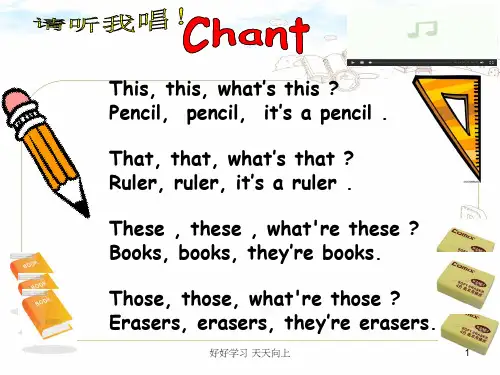
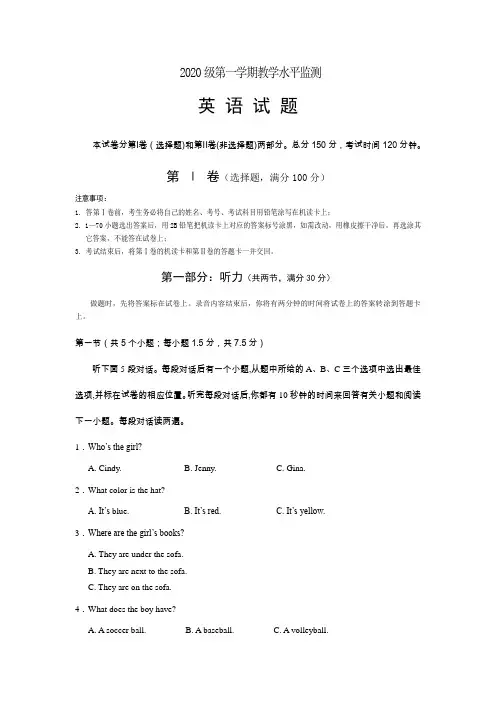
2020级第一学期教学水平监测英语试题本试卷分第Ⅰ卷(选择题)和第Ⅱ卷(非选择题)两部分。
总分150分,考试时间120分钟。
第Ⅰ卷(选择题,满分100分)注意事项:1. 答第Ⅰ卷前,考生务必将自己的姓名、考号、考试科目用铅笔涂写在机读卡上;2. 1—70小题选出答案后,用2B铅笔把机读卡上对应的答案标号涂黑,如需改动,用橡皮擦干净后,再选涂其它答案,不能答在试卷上;3. 考试结束后,将第Ⅰ卷的机读卡和第Ⅱ卷的答题卡一并交回。
第一部分:听力(共两节,满分30分)做题时,先将答案标在试卷上。
录音内容结束后,你将有两分钟的时间将试卷上的答案转涂到答题卡上。
第一节(共5个小题;每小题1.5分,共7.5分)听下面5段对话。
每段对话后有一个小题,从题中所给的A、B、C三个选项中选出最佳选项,并标在试卷的相应位置。
听完每段对话后,你都有10秒钟的时间来回答有关小题和阅读下一小题。
每段对话读两遍。
1.Who’s the girl?A. Cindy.B. Jenny.C. Gina.2.What color is the hat?A. It’s blue.B. It’s red.C. It’s yellow.3.Where are the girl’s books?A. They are under the sofa.B. They are next to the sofa.C. They are on the sofa.4.What does the boy have?A. A soccer ball.B. A baseball.C. A volleyball.5.What does the girl like?A. Milk.B. Ice-cream.C. Hamburgers.第二节(共15小题;每小题l.5分,满分22.5分)听下面5段对话或独白。
每段对话或独白后有几个小题,从题中所给的A、B、C三个选项中选出最佳选项,并标在试卷的相应位置。
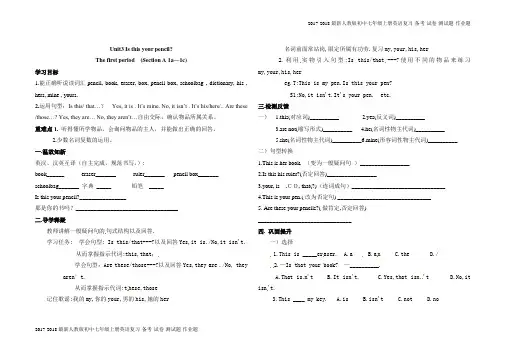
Unit3 Is this your pencil?The first period (Section A 1a—1c)学习目标1.能正确听说读词汇pencil, book, eraser, box, pencil box, schoolbag , dictionary, his , hers, mine , yours.2.运用句型:Is this/ that…?Yes, it is . It’s mine. No, it isn’t . It’s his/hers/.. Are these /those…? Yes, they are… No, they aren’t…自由交际,确认物品所属关系。
重难点1. 听得懂所学物品,会询问物品的主人,并能做出正确的回答。
2.少数名词复数的运用。
一.温故知新英汉、汉英互译(自主完成,规范书写。
):book______ eraser_______ ruler_______ pencil box_______ schoolbag_______ 字典_____ 铅笔_____Is this your pencil?________________那是你的书吗?___________________________________二.导学释疑教师讲解一般疑问句的句式结构以及回答.学习任务: 学会句型: Is this/that---?以及回答Yes,it is./No,it isn't.从而掌握指示代词:this,that;学会句型:Are these/those---?以及回答Yes,they are ./No, they aren’t.从而掌握指示代词:t hese,those记住歌谣:我的my,你的your,男的his,她的her名词前面常站岗,限定所属有功劳.复习my,your,his,her2.利用实物引入句型:Is this/that---?使用不同的物品来练习my,your,his,hereg.T:This is my pen.Is this your pen?S1:No,it isn't.It's your pen. etc.三.检测反馈一) 1.this(对应词)__________ 2.yes(反义词)__________3.are not(缩写形式)__________4.he(名词性物主代词)__________5.she(名词性物主代词)__________6.mine(形容词性物主代词)__________二)句型转换1.This is her book. (变为一般疑问句)_________________2.Is this his ruler?(否定回答)_________________3.your, is,CD, that(?)(连词成句)________________________________4.This is your pen.( 改为否定句) ________________________________5. Are these your pencils?( 做肯定,否定回答)________________________________四. 巩固提升一)选择1.This is _____er aser. A.a B.an C.the D./2.—Is that your book? —__________.A.That is n'tB.It isn't.C.Yes,that isn'tD.No,it isn't.3.This ____ my key. A.is B.isn't C.not D.no4.—Is this your backpack? —___________.A.Yes,it is.B.Yes,it isn't.C.No, it is.D.It isn't.二)试着翻译下列句子1.这是一本书.___________________________________2.那是你的尺子吗?_______________________________是的,它是.______ , ___________________3.这是她的字典吗? ______________________________不,它不是.这是我的字典.________ , _______________. It's __________________.三)句型拓展1.My name is Gina. (对划线部分提问) ________ _______ your name?2.It's an orange. (对划线部分提问) _________ _________ this?3.Is that your notebook? (做否定回答) _______ ,_____________.教(学)后反思:Unit3 Is this your pencil?Period Two (2a---2d)学习目标1. 确认物主关系2. 生词和短语:excuse, me, Excuse me, teacher, about, What about …? Yours, thanks for, help, welcome, You’re welcome.重难点:1. 学习三个表达法:Excuse me. 和What about …? 以及道谢和应答2. 名词性物主代词的运用3. 三个表达法的灵活自如运用。
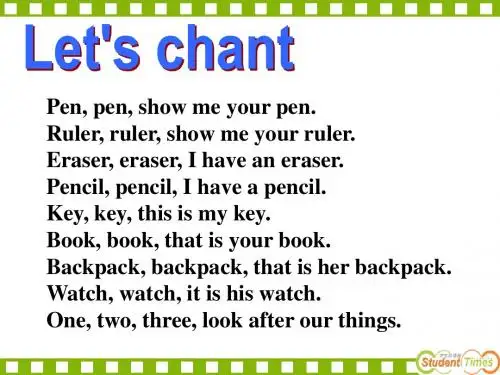
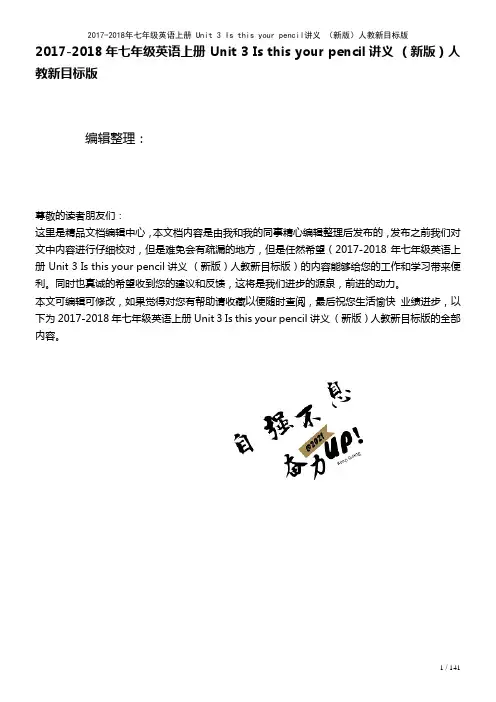
2017-2018年七年级英语上册 Unit 3 Is this your pencil讲义(新版)人教新目标版编辑整理:尊敬的读者朋友们:这里是精品文档编辑中心,本文档内容是由我和我的同事精心编辑整理后发布的,发布之前我们对文中内容进行仔细校对,但是难免会有疏漏的地方,但是任然希望(2017-2018年七年级英语上册 Unit 3 Is this your pencil讲义(新版)人教新目标版)的内容能够给您的工作和学习带来便利。
同时也真诚的希望收到您的建议和反馈,这将是我们进步的源泉,前进的动力。
本文可编辑可修改,如果觉得对您有帮助请收藏以便随时查阅,最后祝您生活愉快业绩进步,以下为2017-2018年七年级英语上册 Unit 3 Is this your pencil讲义(新版)人教新目标版的全部内容。
Unit 3 Is this your pencil?Words and Expressionspencil /’pensl/n. 铅笔book /bʊk/ n. 书eraser /ɪ'reɪzə(r)/ n。
橡皮box /bɒks/ n。
箱;盒pencil box 铅笔盒;文具盒schoolbag /'sku:lbæɡ/ n。
书包dictionary /'dɪkʃənerɪ/ n。
词典;字典 his /hɪz/ pron。
他的mine /maɪn/ pron。
我的hers /hɜ:(r)z/ pron。
她的excuse/ɪk’skju:z/v。
原谅;宽恕me /mi:/ pron。
(I 的宾格)我excuse me 劳驾;请原谅thank /θæŋk/ v. 感谢;谢谢teacher /'ti:tʃə(r)/ n. 老师;教师about /ə'baʊt/ prep。
关于What about…?(询问消息或提出建议)……怎么样?……好吗?yours /jɔ:(r)z/ pron。
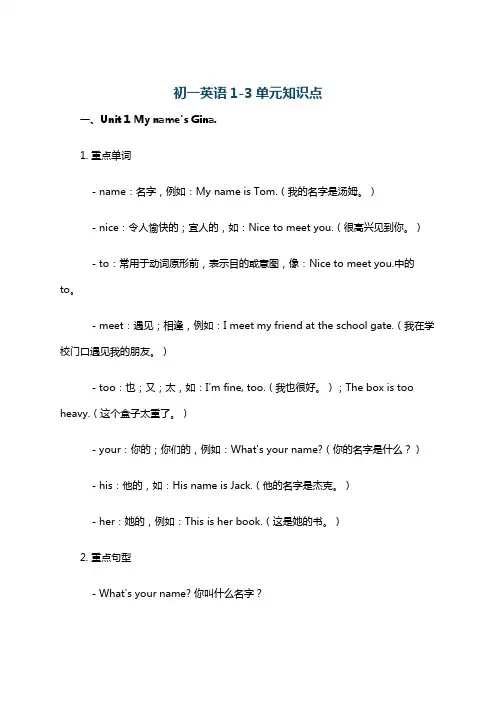
初一英语1-3单元知识点一、Unit 1 My name's Gina.1. 重点单词- name:名字,例如:My name is Tom.(我的名字是汤姆。
)- nice:令人愉快的;宜人的,如:Nice to meet you.(很高兴见到你。
) - to:常用于动词原形前,表示目的或意图,像:Nice to meet you.中的to。
- meet:遇见;相逢,例如:I meet my friend at the school gate.(我在学校门口遇见我的朋友。
)- too:也;又;太,如:I'm fine, too.(我也很好。
);The box is too heavy.(这个盒子太重了。
)- your:你的;你们的,例如:What's your name?(你的名字是什么?) - his:他的,如:His name is Jack.(他的名字是杰克。
)- her:她的,例如:This is her book.(这是她的书。
)2. 重点句型- What's your name? 你叫什么名字?- 回答:My name's...或者I'm...,例如:What's your name? My name's Gina.(你叫什么名字?我的名字是吉娜。
)- Nice to meet you. 很高兴见到你。
- 回答:Nice to meet you, too.(也很高兴见到你。
)- Are you...? 你是……吗?- 回答:Yes, I am. / No, I'm not.例如:Are you Tom? Yes, I am.(你是汤姆吗?是的,我是。
)3. 语法点- 形容词性物主代词:your(你的/你们的)、his(他的)、her(她的)。
形容词性物主代词后面要接名词,用来表示所属关系,如:your book(你的书),his pen(他的钢笔),her bag(她的包)。
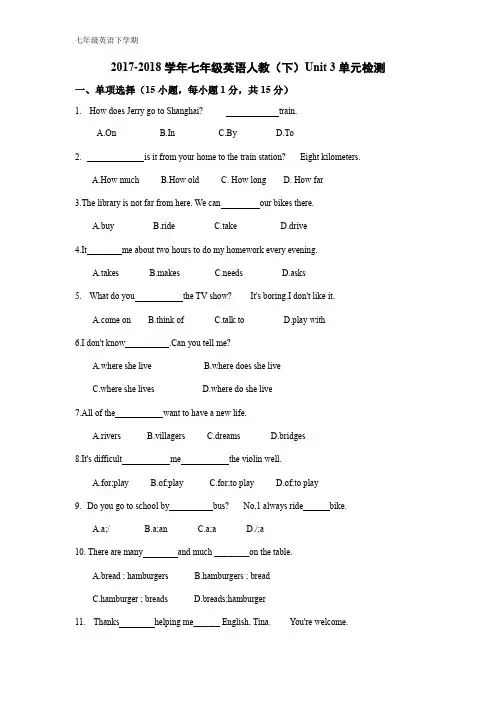
2017-2018学年七年级英语人教(下)Unit 3单元检测一、单项选择(15小题,每小题1分,共15分)1. --How does Jerry go to Shanghai? --train.A.OnB.InC.ByD.To2.--is it from your home to the train station? --Eight kilometers.A.How muchB.How oldC. How longD. How far3.The library is not far from here. We can our bikes there.A.buyB.rideC.takeD.drive4.It me about two hours to do my homework every evening.A.takesB.makesC.needsD.asks5. --What do you the TV show? --It's boring.I don't like it.e onB.think ofC.talk toD.play with6.I don't know .Can you tell me?A.where she liveB.where does she liveC.where she livesD.where do she live7.All of the want to have a new life.A.riversB.villagersC.dreamsD.bridges8.It's difficult me the violin well.A.for;playB.of;playC.for;to playD.of;to play9.--Do you go to school by bus? --No,1 always ride bike.A.a;/B.a;anC.a;aD./;a10. There are many and much ________on the table.A.bread ; hamburgersB.hamburgers ; breadC.hamburger ; breadsD.breads;hamburger11. --Thanks helping me______ English, Tina. --You're welcome.A.for ; aboutB. for; withC.about ; withD.to ; for12. --Is this your bike,Jane? --Yes,it is.I it to school every day.A.getB.takeC.rideD.set13.I usually walk home after school at 4:30 p.m.A./B.toC.withD.by14. --How do they the river? --By boat.A. findB.knowC. thinkD.cross15.It's so .You can't get there on foot.A.newB. farC. cleanD.old二、完形填空(10小题,每小题1.5分,共15分)There are different kinds of TV programs for you. When you 16 the TV programs, your brain cells (脑细胞) keep active. So it is 17 for you.Now more and more people are very 18 . They need a way to make 19 relaxed. Watching TV is an easy 20 to make it. You can 21 your interest on TV and think less about your trouble.There are many educational programs on TV. You can get a lot of knowledge 22 watching TV. For example, you can 23 about the history of other countries. When you watch TV with your family, you can 24 your ideas with them. You will have a great time by watching a funny 25 . When you watch TV, you can learn English, and you can also learn about the latest news.16.A. read B. take C. watch D. study17.A. useless B. helpful C. terrible D. bad18.A. free B. busy C. important D. successful19.A. himself B. herself C. myself D. themselves20.A. subject B. day C. way D. lesson21.A. start B. find C. think D. buy22.A. of B. about C. by D. as23.A. make B. learn C. hold D. write24.A. share B. love C. put D. pick25.A. program B. list C. photo D. book三、阅读理解(10小题,每小题2分,共20分)阅读下面四篇语言材料,然后按文后要求做题。
![[K12学习]2017_2018学年七年级英语上册Unit3Isthisyourpencil综合测评新版人教新目标版](https://uimg.taocdn.com/784fd621a2161479171128a1.webp)
Unit 3综合测评(分数:100分时间:90分钟)第Ⅰ卷听力部分(20分)Ⅰ.听对话,选择与所听内容相符的图片(5分)1.2.3.4.5.Ⅱ.听句子, 选择正确答语(5分)6.A.I’m Joy. B.It’s 555-7523. C.That’s a map.7.A.No. B.I’m Mary. C.It’s red.8.A.It’s a pencil. B.Yes. C.Thank you.9.A.It’s a key. B.Yes, it is. C.No, it is.10.A.Yes. B.It’s a case. C.C-A-S-E.Ⅲ.听对话,选择正确答案(5分)11.What color is Lucy’s pencil?A.Yellow.B.Orange.C.Black.12.What’s in the Lost and Found?A.A red pen.B.A blue pen.C.A green ruler.13.Is that Tom’s pencil box?A.Yes,it is.B.No,it isn’t.C.I don’t know.14.What’s Gina’s telephone number?A.441-3445.B.440-3245.C.420-2354.15.Whose(谁的) book is it?A.Tom’s.B.Ji m’s.C.Tony’s.Ⅳ.听短文,完成表格(5分)LostName:John 16..Lost:A backpack.Color:Black and 17..Things in it:A book,a dictionary,a notebook,a pencil box,18. and 19..Phone number:20..第Ⅱ卷笔试部分(80分)Ⅴ.单项选择(10分)21.My book is in my .A.penc il boxB.dictionaryC.ID cardD.schoolbag22.—This book is mine. that book?—It’s Linda’s.A.What’sB.What aboutC.How’sD.Is23.—Is that your quilt?—.It’s her quilt.A.Yes, it isB.Yes, that isC.No, it isn’tD.No, that isn’t24.These aren’t .They’re my brother’s.A.pen;mineB.pens;mineC.pen;myD.pens;my25.This is a .His ruler and pens are in it.A.watchB.ringC.baseballD.pencil box26.(2016·北京中考)Paul’s mother is a nurse.She works a hospital.A.withB.onC.ofD.in27.(2016·天津中考)I can’t find my ticket.I think I have lost .A.itB.oneC.thisD.them28.This is pencil and that is eraser.A.a;aB.an;anC.a;anD.an;a29.(2016·山西中考)In our life,we need to those people who help us,such as our parents,teachers and friends.A.thankB.remindC.teach30.—.Do you know his name?—, I don’t know.A.Sorry;Excuse meB.Hello;YesC.Excuse me;SorryD.Hi;ErⅥ.完形填空(15分)ALook at the lost and found notice.31 that?It’s an eraser.I think(想) it’s his 32 .And I lost a 33 of keys.If(如果) you find the keys, please call me34 555-6741.35 name is Maggie White.Thank you!31.A.What B.It’s C.What’s D.This32.A.book B.eraser C.keys D.quilt33.A.gold B.set C.nice D.good34.A.in B.on C.at D.to35.A.My B.His C.Her D.YourBThis boy is Peter Smith.His 36 name is Peter.His 37 name is Smith.This is 38 school.His school 39 number is 200-4856.His teacher is Miss White.Miss White 40 a good teacher.Li Min is a Chinese boy.He is Peter’s good 41 at school.Look!42 a pencil box.Is it 43 ?I 44 know.Let’s 45 Li Min at 495-6548.36.A.first B.family st D.one37.A.first B.good st D.this38.A.you B.that C.his D.itputer C.phone D.book40.A.no B.not C.is D.am41.A.father B.friend C.boy D.class42.A.What’s B.This C.That’s D.The name’s43.A.Li Min B.Li Min’s C.Li Min is D.The Li Min44.A.don’t B.isn’t C.am not D.do45.A.ask B.call C.write D.lookⅦ.阅读理解(20分)AFoundThi ng:A watchColor:BlackName:CindyTelephone number:359-5934LostI’m Linda.I lost a yellow ring.Please call Bill or me.My phone number is 485-3982.Bill’s telephone number is 683-5912.FoundIs this your jacket?It’s a red jacket.And an ID card is in it.My name is Mike.My telephone number is 239-5178.46.Cindy found a(n).A.watchB.ringC.jacketD.ID card47. lost a ring.A.CindyB.LindaC.BillD.Mike48.What’s Mike’s telephone number?A.359-5934.B.485-3982.C.239-5178.D.683-5912.49.What color is the jacket?A.Black.B.White.C.Yellow.D.Red.50.Which of the following is TRUE?A.Bill lost an ID card.B.The watch is yellow.C.Mike found a jacket with an ID card.D.Cindy’s telephone number is 683-5912.BA:Excuse me,Zhang Yang.What’s this?B:Oh,it is a photo.A:Who’s the girl in it?Is she your sister?B:No,she isn’t.She’s my friend.A:What’s her name?B:Her name is Kelsey King.A:How do you spell it?B:K-E-L-S-E-Y,Kelsey,K-I-N-G,King.A:Well,is that your cat?B:A cat?Two cats are in it.The black one or the yellow one?A:The black one.B:Oh,yes,it’s mine.And the yellow one is our neighbor’s(邻居的).A:It’s really a nice picture.51.Who is Zhang Yang’s friend?A.Kelsey King.B.The yellow cat.C.The black cat.52.What color is Zhang Yang’s cat?A.Yellow.B.White.C.Black.53.How is the photo?A.Nice.B.Happy.C.Blue.54.How many cats are white?A.None(没有).B.One.C.Two.55.What are they talking about(谈论)?A.Kelsey King’s photo.B.Zhang Yang’s photo.C.Zhang Yang’s cat.Ⅷ.根据短文内容,从下面方框中选择恰当的选项补全短文(10分)A.This is my mother.B.This is a photo of my family.C.We(我们) are a happy family.D.His name is Jill.Hi!My name is Kate.56.This is my father.His name is Frank.57. Her name is Mary.This is my elder brother.Hi s name is Jack.This is my younger brother.58.Oh,this is me.59.Ⅸ.任务型阅读(5分)读下面的寻物启事和招领启事, 回答下列问题。
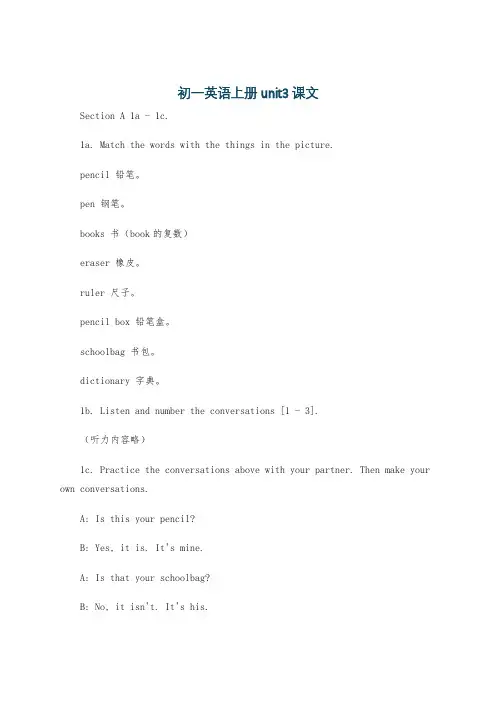
初一英语上册unit3课文Section A 1a - 1c.1a. Match the words with the things in the picture.pencil 铅笔。
pen 钢笔。
books 书(book的复数)eraser 橡皮。
ruler 尺子。
pencil box 铅笔盒。
schoolbag 书包。
dictionary 字典。
1b. Listen and number the conversations [1 - 3].(听力内容略)1c. Practice the conversations above with your partner. Then make your own conversations.A: Is this your pencil?B: Yes, it is. It's mine.A: Is that your schoolbag?B: No, it isn't. It's his.Section A 2a - 2d.2a. Listen and check (√) the things you hear.(听力内容略)2b. Listen again. Complete the conversation with the words in the box. pencil your it's his it isn't.A: Excuse me. Is this your 1. ______?B: No, 2. ______. It's Tom's.A: And is this his green pen?B: No, it isn't. The blue pen is 3. ______.A: What about this dictionary? Is it 4. ______?B: Yes, 5. ______ is. Thank you for your help.2c. Ask and answer questions about the things in 2a.A: Is this your eraser?B: Yes, it is.A: Is that your ruler?B: No, it isn't. It's hers.2d. Role - play the conversation.Teacher: Hi, Anna. Are these your pencils?Anna: No, they're Bob's.Teacher: And is this his green pen?Anna: No, it isn't. The blue pen is his.Teacher: What about this dictionary?Anna: It's Helen's. And the green pen is hers, too.Teacher: And the eraser? Is that yours?Anna: Yes, it is.Section B 1a - 1e.1a. Match the things with the right owners. Write the letters on the things.1. ______ pencil a. Tom.2. ______ book b. Mike.3. ______ eraser c. Mary.4. ______ ruler d. John.5. ______ schoolbag e. Sonia.1b. Listen and check (√) the things you hear in 1a.(听力内容略)1c. Listen again. Write down the things Tom and his sister lost.(听力内容略)1d. Role - play the conversation between Tom and his sister.Tom: I lost my schoolbag.Sister: What color is it?Tom: It's blue.Sister: What's in it?Tom: My books, my pencil box and my eraser are in it.Sister: OK. Let's go to the Lost and Found case.Tom: Great.1e. Make your own conversations to talk about the lost and found things.A: I lost my pen.B: What color is it?A: It's black.B: Where did you lose it?A: I think I lost it in the library.Section B 2a - 2c.2a. Read the notices on the Lost and Found board. Write down the lost things and the found things.Lost:1. A set of keys.2. A blue watch.Found:1. An ID card.2. A purple schoolbag.2b. Read the notices again and circle the words for things.keys, watch, ID card, schoolbag.2c. Write your own lost or found notice with your name and phone number.Lost:My red pencil box. There are two pencils, an eraser and a ruler in it. My name is Jack. Please call me at 685 - 5588.或者。
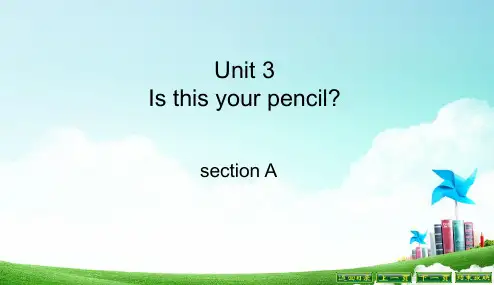
Unit 3 Is this your pencil?单元检测试卷考试时间:100分钟满分120分第一卷听力部分(20分)一、听录音,选出你所听到的单词,听1遍(每小题1分,共5分)1. A. baseball B. ring C. backpack2. A. his B. this C. case3. A. school B. spell C. pencil4. A. it B. pen C. what5. A. list B. lost C. last二、听句子,选出恰当的应答语,听1遍(每小题1分,共5分)1. A. Yes, it is. B. No, it is. C. Yes, this is.2. A. No, that’s my key. B. Yes, it is. C. No, it is.3. A. It’s a watch. B. This is a ring. C. No, it isn’t.4. A. SCHOOL. B. It’s a school. C. Yes, it is.5. A. Yes, it isn’t. B. Yes, it is. C. No, this isn’t.三、听句子,补全句子中所缺的单词,听1遍(每小题1分,共5分)1. Is that your __________?2. No, it isn’t my__________.3. That’s her __________.4. __________do you __________“backpack”?5. __________me. Is this your case?第二卷笔试部分(100分)一、单项选择(每小题1分,共20分)1. That’s ____ ID card.A. aB. anC. she’sD. /2. ---Tom, is this ____ pen?---Yes. It’s my pen.A. IB. youC. myD. your3. The boy’s name is Kevin Smith. Kevin is his _____ name and Smith is his _____ name.A. last; firstB. family; givenC. given; fullD. first; last4. ---Jim, is this a map?--- _____.A. Yes, it’sB. Yes, it isC. No, it isD. No, this isn’t5. ---Are you Jenny?--- ______.A. Yes, I’mB. Yes, I’m notC. No, I amD. Yes, I am6. —Is this your baseball? —Please call me 555-6879.A. forB. atC. inD. for7. Look at my ring. _____ new.A. ItsB. ItC. It’sD. Is8. _____ my book. ____ your book.A. This is, That’sB. This’s, That’sC. This is, It’sD. This’s, That is9. ---Is this your watch _____ the Lost and Found case, Jack?---Yes,_______A. at, it’sB. in, it isC. in, this isD. for, this’s10. —Is this your eraser?—No, it isn't. I think _____.A. it her eraserB. its her eraserC. it's her eraserD. it’s him eraser11. ---Is this ______ computer game? ---Yes, _______ is ______ computer game.A. his; it,meB. your; this,hisC. your; it,myD. you; it,my12. --- What’s this in English? --- ______.A. Yes, it’s a watch.B. It’s my watchC. It’s a watchD. No, it’s a watch.13. ---Is that ______ English dictionary? --- No, it’s _____ Chinese one.A. a, aB. an, anC. a, anD. an, a14. _____ is my father. ______ name is Dave Smith.A. He; He’sB. His; HeC. He; HisD. He’s; His15. ______ are good friends.A. I and JennyB. Tom and meC. Me and JennyD. Jenny and I16. Is this your ______?A. a notebookB. notebookC. notebookD. notebooks17. What is this? ______.A. These are booksB. It’s a bookC. They are pensD. That aren’t pens18. —Your dress is very nice. — ______.A. Thank youB. SorryC. OKD. No, it’s not nice19. —Is that a cat? —______A. Yes, that is.B. Yes, it is.C. Yes, that isn’tD. No. It is.20. It’s a ball pen, ___? It’s a pencil.A. what are thisB. and what is thisC. this is whatD. what’s i t二、完型填空: (每小题1分,共10分)This boy is Peter Smith. His 21 name is Peter. His 22 name is Smith. This is 23 school. His school 24 number is 20048567.His teacher is Miss White. Miss White 25 a good teacher. Li Min is a Chinese boy. Li Min is his good 26 at school. Look! 27 a pencil sharpener. Is the pencil sharpener 28 ? I 29 know. Let’s 30 Li Min at 495-6548.21. A. first B. family C. last D. one22. A. first B. good C. last D. this23. A. you B. that C. his D. it24. A. computer B. name C. phone D. ID card25. A. no B. not C. is D. am26. A. father B. friend C. boy D. class27. A. What’s B. This’ s C. That’s D. The name’s28. Li Min B. Li Min’s C. Li Min is D. The Li Min29. A. don’t B. isn’t C. am not D. do30. A. ask B. call C. write D. look三、阅读理解(每小题2分,共20分)AI am Mr. Li. I teach English. When I work, I use paper and a pen. I sit on a chair near a desk.I work for eight hours every day. In class, I write on the blackboard. Every day at noon I have a rest(休息). But, today my clock is broken. So I don’t know when to have a rest. But I am not worried(担心). When I am hungry, I know it is twe lve o’clock. Then I will leave(离开) my desk, chair, paper and pen, and go to eat in the dining hall.31. What does Mr. Li teach?A. English.B. Chinese.C. Math.D. Computer.32. How many hours does he work?A. Eight.B. Seven.C. Six.D. Four.33. Where does he write in class?A. On the book.B. On the notebook.C. On the blackboard.D. On the paper.34. When does he have lunch?A. At 11.B. At 11:30.C. At 12.D. At 12:30.35. Does he eat lunch in the office(办公室)?A. Yes, he does.B. No, he doesn’t.C. I don’t know.D. Maybe(可能).BMy name is Doris Miller. I’m a fourteen-year-old girl. I’m from London(伦敦). But now I’m in Beijing. This is my school. It’s No. 5 Middle School. My Chinese teacher’s name is Li Tao. Atschool I have two good friends. One is English, and the other is Chinese. My phone number is 88526230, and my e-mail address(地址) is dorismiller@. I want to be your friend. You can call me or send(发送) an e-mail to me.根据短文内容判断正(T)误(F)。
初一英语1到3单元知识点一、Unit 1 My name's Gina.(一)重点单词。
1. name.- 名词,意为“名字;名称”。
例如:My name is Tom.(我的名字是汤姆。
)2. nice.- 形容词,意为“令人愉快的;宜人的”。
常用来形容人或事物给人的感觉。
例如:She is a nice girl.(她是一个友好的女孩。
)3. to.- 这里主要用作不定式符号,例如:Nice to meet you.(很高兴见到你。
)4. meet.- 动词,意为“遇见;相逢”。
例如:I meet my friend at the school gate.(我在学校门口遇见我的朋友。
)5. too.- 副词,意为“也;又;太”。
表示“也”时,用于肯定句末。
例如:I'm fine, too.(我也很好。
)6. your.- 形容词性物主代词,意为“你的;你们的”。
用来修饰名词。
例如:Your book is on the desk.(你的书在桌子上。
)7. his.- 形容词性物主代词,意为“他的”。
例如:His name is Jack.(他的名字是杰克。
)8. her.- 形容词性物主代词,意为“她的”。
例如:Her pen is red.(她的钢笔是红色的。
)(二)重点短语。
1. name's = name is.- 例如:My name's Lily. = My name is Lily.(我的名字是莉莉。
)2. first name.- 意为“名字”,在英语中,名字在前,姓氏在后。
例如:My first name is Tom.(我的名字是汤姆。
)3. last name.- 意为“姓”。
例如:My last name is Green.(我的姓是格林。
)4. nice to meet you.- 用于初次见面时打招呼,回答是“Nice to meet you, too.”(很高兴见到你。
矿产资源开发利用方案编写内容要求及审查大纲
矿产资源开发利用方案编写内容要求及《矿产资源开发利用方案》审查大纲一、概述
㈠矿区位置、隶属关系和企业性质。
如为改扩建矿山, 应说明矿山现状、
特点及存在的主要问题。
㈡编制依据
(1简述项目前期工作进展情况及与有关方面对项目的意向性协议情况。
(2 列出开发利用方案编制所依据的主要基础性资料的名称。
如经储量管理部门认定的矿区地质勘探报告、选矿试验报告、加工利用试验报告、工程地质初评资料、矿区水文资料和供水资料等。
对改、扩建矿山应有生产实际资料, 如矿山总平面现状图、矿床开拓系统图、采场现状图和主要采选设备清单等。
二、矿产品需求现状和预测
㈠该矿产在国内需求情况和市场供应情况
1、矿产品现状及加工利用趋向。
2、国内近、远期的需求量及主要销向预测。
㈡产品价格分析
1、国内矿产品价格现状。
2、矿产品价格稳定性及变化趋势。
三、矿产资源概况
㈠矿区总体概况
1、矿区总体规划情况。
2、矿区矿产资源概况。
3、该设计与矿区总体开发的关系。
㈡该设计项目的资源概况
1、矿床地质及构造特征。
2、矿床开采技术条件及水文地质条件。